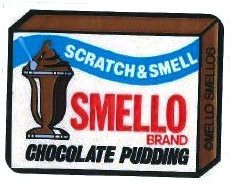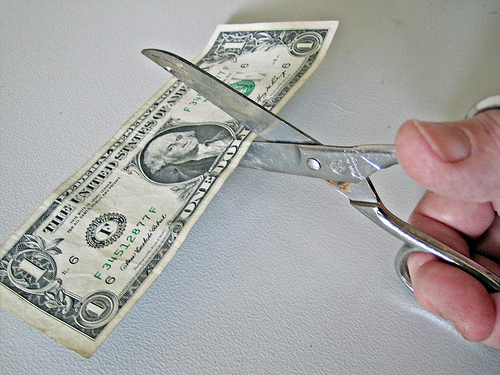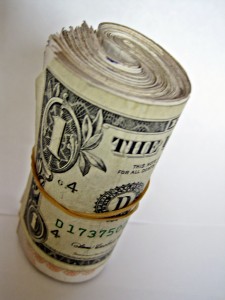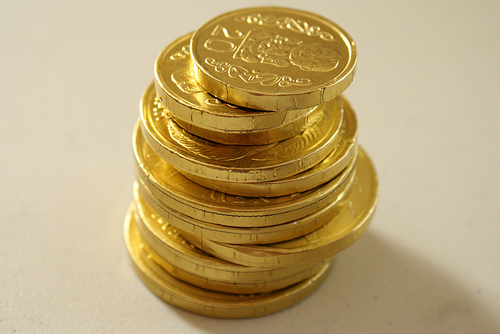Wacky World of Choc Wednesdays: Chocolate (2008): She’s Sweet But Deadly
Chocolate, a film released in 2008, features a main character who is an autistic martial arts prodigy. Her most important training food? Chocolate.
Watch the trailer:
Read the synopsis:
Prachya Pinkaew, director of Ong Bak: The Thai Warrior, returns with CHOCOLATE, an explosive new martial arts masterpiece starring his new protégé, “Jija” Yanin Vismistananda, who spent five years training for the role. Jija plays Zen, a young autistic girl who grows up next to a Muay Thai boxing studio and is raised on a steady diet of chocolate and marathon viewings of Tony Jaa and Bruce Lee films. Zen’s father, a Japanese gangster, has been driven out of the country by a rival Thai gang, so her mother has been forced to raise her alone.
It becomes clear over time that Zen has miraculously absorbed formidable Muay Thai techniques from watching the boxers next door and repeated viewings of martial arts classics. When Zen’s mother is diagnosed with cancer and the cost of treatments prove overwhelming for the family, Zen sets out with her cousin on a violent mission to collect debts from the corrupt gangsters that owe her mother money.
Featuring death-defying stunts and a charming newcomer who is sure to blow the minds of martial arts fans everywhere, CHOCOLATE represents Prachya’s proper follow-up to the smash success of Ong Bak.
(via Magnolia Pictures)
“‘CHOCOLATE’ is a sweet, brutal, bloody treat.” – Harry Knowles, Ain’t It Cool News
“One of the most anticpated films for well over a year, CHOCOLATE is madness. Madness of the brilliant, painful kind.” – Todd Brown, Twitch
Wow. Need I say more?
The film is widely available to watch online, e.g. via YouTube or Netflix.
Chocolate projects on Kickstarter
Kickstarter is an inspirational favorite of mine. In the organization’s own words: “Kickstarter is the largest funding platform for creative projects in the world. Every week, tens of thousands of amazing people pledge millions of dollars to projects from the worlds of music, film, art, technology, design, food, publishing and other creative fields.”
The Kickstarter community has been good to chocolate, with 40 or so projects proposed and many of them completely funded. Click here for a list of projects past and present.
One project in particular stands out right now, with just 12 days to go before the funding period expires: Madre Chocolate’s An Edible History of Chocolate.
Here’s a video with an overview of the company and the project, featuring Madre’s cofounders, David Elliott and Nat Bletter, and gorgeous shots of Mexico, Hawaii, and cacao as it makes it way from bean to bar:
From the project’s page:
How will your donations make this project happen? We’ve already done the legwork. Your contributions will be used to pay fair prices to growers and transport the cacao and spices from Chiapas to our small shop on the island of Oahu, Hawaii. A portion will also be destined for equipment improvements to help us efficiently process the lot with the utmost attention to quality.
Madre Chocolate’s bars are beautiful and tasty. The company has a social mission to bring chocolate back to its roots by working closely with cacao farmers and their communities, building relationships founded on mutual respect. As a bonus, there are a number of excellent rewards for donations. This project is a treat!
If this project appeals to you, please consider donating before the end date: Sunday August 14, 5:47AM EDT.
See Madre’s website for news and information, links to their online shop and class schedule, and more.
In addition, a number of journalists and bloggers have published profiles of the company:
Chocolate with a Conscience, Honolulu Weekly
Food La La: Going Gourmet with Madre Chocolate, Honolulu Pulse
In Chocolate Heaven: Going From Bean to Bar with Nat & Dave from Madre Chocolate, Kahakai Kitchen
And if you’re looking for reviewers’ opinions on Madre Chocolate, check out the following:
C-spot, Madre Chocolate bar reviews
The District Chocoholic, 7 reviews (1, 2, 3, 4, 5, 6, 7)
Madre Chocolate on Yelp
There are a couple of other ongoing chocolatey Kickstarter campaigns, too. They are The Art of Chocistry and Chocolate Love.
Chocolate in Pictures
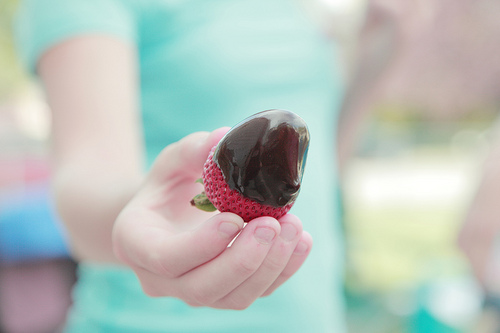
Chocolate Dipped Strawberry by Poppy Thomas-Hill
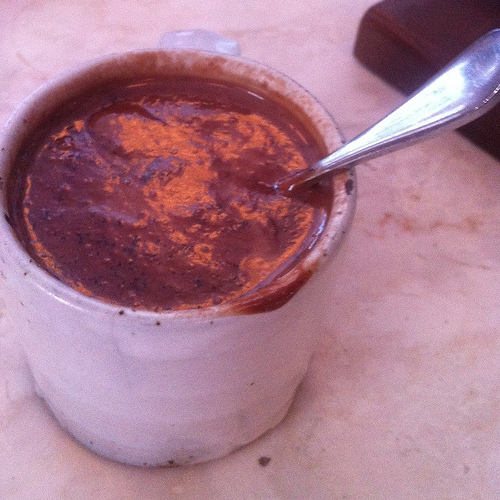
Liquid Truffle at French Broad Chocolate Lounge by David Berkowitz
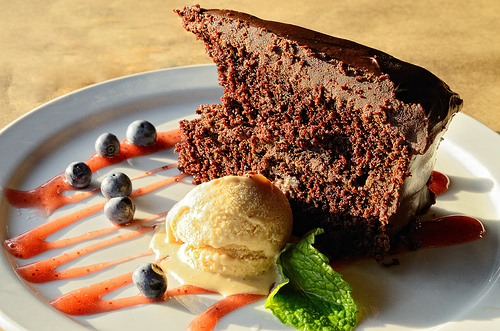
Chocolate Cake by Ralph Daily

Pure Chocolate by Dakotilla

Chocolate in the Grass by Jens Schott Knudsen

Chocolate Brownies by Waleed Alzuhair

Chocolate Camera by Mitchell Joyce
Wacky World of Choc Wednesdays: Chocolate Scent Marketing
Over the past couple of weeks, I’ve struggled to ward off the last of a dreaded summer cold. Fighting a fever while Boston matched its highest temperature ever (!) wasn’t exactly fun, but my main complaint stems from the cold’s interference with my sense of smell. For several days, food lost all its appeal and the thought of eating normally beloved chocolate actually made me cringe. It’s only temporary, I told myself over and over, hopeless with despair. As is so often the case when I face times of strife, I begged the internet for distraction.
Turns out, marketers have long understood the importance of scent to triggering the desires of smellers. That’s why, when I read this article in my sinus pressure induced haze, all I could think was “I wish I could go smell that right now!”
From the article:
A supermarket chain thinks the fastest way to its customers’ pockets is through their noses, so it’s filling up the aisles with intoxicating, artificial food aromas to entice customers to buy.
A Net Cost supermarket in Brooklyn, N.Y., has specialized scent machines mounted on its walls that fill the air with a never-ending scent of decadent milk chocolate or fresh-baked bread, among other scents.
The Brooklyn supermarket has five of the machines, including a grapefruit smell in the produce section, chocolate in the candy aisle and rosemary focaccia by the bakery.
These scent machines are pricey, costing the supermarket $99/month. The store’s merchandise coordinator, however, states that she has already seen a 7% rise in produce sales, which she attributes to use of the machines. Not too shabby!
Learn more in this video from CBS News:
There are a number of other notable chocolate scent marketing cases. For example, when Verizon launched its LG Chocolate phone back in 2006, it used small plastic strips that emitted chocolate scent in its stores to lure customers in and excite their interest. And, according to an in-depth article from the Los Angeles Times, chocolate scent marketing has proven efficacy: “In 2006, when ScentAndrea, a scent marketing company in Santa Barbara, put chocolate scent strips on 33 vending machines in factory break rooms in Ventura (plus a sign that said it was Hershey’s candy people were smelling) the brand’s sales tripled.”
The product lines for scent marketing are really fun to learn about – there are scent cannons to remove odors, scent lights to project images and release scents, scented digital signage for use in store displays… There’s even a whole bunch of so called scent science in process. And just when I was thinking it’s too bad we can’t yet smell scents through our web browsers, I ran across this Scent Mouse, which can be customized to release up to four scents during the exploration of a website, and the ScentScape which claims to deliver “the NEXT Dimension of Digital Media” by releasing scents during gaming.
The scent marketing industry brings in hundreds of millions of dollars a year and is still expanding. Get a whiff of that chocolate.
For a basic intro to the field, check out this video, “What is Scent Marketing”:
Also check out the following companies and institutions to get a better sense for the industry:
ScentAir
ScentAndrea
Scent Marketing Institute
Sniff, sniff!
How to save money at Whole Foods
If you’re like me and you’ve got a cabinet full of chocolate and all you can think of is how much more you need to buy and try, and you dream that all your out of town trips could center around visiting chocolatiers, and when you bake anything for a loved one you can’t live with yourself unless you dump at least a pound of high quality chocolate into the batter, then you’re probably spending a good chunk of change on the bittersweet stuff.
I have strong opinions regarding the cost of chocolate (and other foods) and on what I believe to be unrealistic expectations for cheapness perpetuated by a broken food system and bizarre prices that are only possible due to poorly directed and heavily lobbied for farm and industry subsidies, multinational corporations run amok, and the exploitation of laborers at many stages of production… PHEW!
On the other hand, food insecurity is a major problem in the US, with about 1 in 7 Americans currently on food stamps. This grave issue goes beyond just cost to availability. Check out the USDA Food Desert Locator, which provides a “spatial overview of low-income neighborhoods with high concentrations of people who are far from a grocery store.” On this map, huge swaths of our country, home to millions of people, are highlighted in pink, meaning food access is extremely limited in those areas.
News on food insecurity is everywhere these days, as farmers struggle to grow their own food while producing large quantities of commodity crops and urban-suburban families suffer from limited access to fresh food options. First Lady Michelle Obama, who has valiantly intervened in numerous food and health related problems in our country, is now directly involved in working to eliminate food insecurity.
Here in Massachusetts, where, on the whole, we are fortunate to have readily available food, I have nonetheless observed the struggles of friends and acquaintances for appropriate food access. A recent Boston Globe article detailed one type of grueling local food scarcity amongst visitors to food pantries. There is a lot more to say on all of this in subsequent posts. The messy interconnectedness of our global food system sometimes seems enough to drive us all batty. Let it stand for now that the development of solutions to food insecurity problems greatly preoccupies me.
That’s why last weekend, while my Twitter and Facebook feeds erupted with Women’s World Cup excitement, I was equally engrossed in a sporting event of sorts — the Extreme Couponing marathon on TLC. Watching this show positively titillates. It’s like riding a roller coaster or bungee jumping… or legally robbing a supermarket. The short of it: intensely organized people spend dozens of hours finding, cataloging, and calculating coupons, then go to the grocery store where they acquire hundreds of dollars worth of products for nearly free. Watch the show. The extreme couponers are compulsive pennypinching heroes, true pros at gaming food costs! And most of them, as it turns out, were inspired to coupon in the extreme when their own families faced food insecurity.
There are countless blogs and guides online with tips for saving money at supermarkets, drug stores, and big-box stores. Given my own food politics inclinations and my geographic location, I tend to do most of my food shopping at Whole Foods, local family-owned shops, and seasonal farmers markets. I take money saving and frugality seriously, and I love a good bargain as much as the next person.
Whole Foods is still subject to the well known but somewhat unfair and outdated epithet, Whole Paycheck. Its brand is associated with privileged yuppies and gentrification as much as it is with healthy, ethical food. Boston became a part of the debate over these associations and the store’s pricing this year when citizens of the neighborhood of Jamaica Plain spoke out for and against the planned opening of a Whole Foods store there. In response to concerns over pricing, it was found that, in fact, Whole Foods Isn’t That Expensive. And the truth of the matter is, here in Cambridge, Whole Foods is an excellent shopping option, and often, because we are lucky to have three locations within the city’s borders, it is the most convenient one for people of diverse income levels.
Extreme couponing is not a realistic goal for most people, nor will it ever be THE solution to food insecurity problems. Yet the skills that extreme couponers have and their heightened awareness surrounding shopping and budgeting is something that we can all benefit from. Recently, in the interest of improving my own food shopping skills, I challenged myself to learn how to save serious cash when shopping at Whole Foods. So, no matter what drives you to coupon, whether its to deal with the very real problem of food insecurity, because you want to save or donate money, or because you’ve got a tongue-in-cheek desire to accommodate a chocolate buying habit, I hope that the information below will prove useful.
According to my preliminary calculations, I should be able to save anywhere from $25 or more on my Whole Foods grocery bill next week.
Here’s what I’ve learned:
Tips for saving money at Whole Foods
- Buy local, seasonal produce and save. While this isn’t a hard and fast rule, I often find that local, seasonal fruits and vegetables are less costly than imported, out of season ones. I buy organic produce almost exclusively now, for the simple reason that pesticides are harmful for farm workers, the environment, and me. Plus, my experience has been that organic produce most often tastes much better. Admittedly, organic produce is sometimes more expensive than non-organic, but well, healing people and the environment is very expensive, and this is a cost-benefit choice that I am fortunate enough to make.
- Consult The Whole Deal Value Guide, which is available by email, online, or in stores. The Whole Deal is published throughout the year. It includes the following money saving options: dozens of printable coupons, a list of Sure Deals (seasonal sale items), Three Under $3 (three kitchen staples for under $3 each), Budget Meal suggestions, and Budget Friendly Recipes. Numerous blogs also take on the challenge of budget friendly meal planning.
- Download the PDF file of Weekly Buys for your local store. Do this by going to the Whole Foods main website. On the home page, you will see a highlighted box with the text “What’s On Sale?” Input your state and choose your local store, then click download. Note: In addition to the Weekly Buys, there is an in store publication called “Weekender” with last-minute specials for Friday, Saturday, and Sunday. My local Whole Foods offers significant discounts on *at least* 50 items each week.
- When you’re in the store, look around and ask. Sometimes there are in store specials like Madness Sales or One Day Sales that you won’t necessarily know about unless you run across them at the store. You can also stop by the Customer Service Desk and ask questions about deals. The staff at my local store are wonderful and very helpful; it is always a pleasure to speak with them.
- Volume discounts. If you buy a full case or a large amount of one of your much used items, you might be eligible for a volume discount from the store (sometimes as much as 10 or 20% off). Ask at the Customer Service Desk for more information.
- Bulk bins. The bulk section of any Whole Foods store is easily distinguishable by its large clear bins filled with grains, dried beans, dried fruits, nuts, candies, and more. You self select your quantity, use minimal packaging, and store things without refrigeration, making this an ecofriendly and economical choice.
- Buy “generic” from the wide range of Whole Foods’ own 365 Everyday Value brand. This post from Apartment Therapy discusses the cost saving possibility of many of the high quality 365 products.
- Sign up for all the Whole Foods email newsletters, which contain information about coupons, sales, and more. (Bonus: If you sign up right now, you can enter to win a $50 Gift Card.)
- Find manufacturer’s coupons for your favorite brands and use them at Whole Foods. There are many ways to find these coupons and they are elaborated in wonderful detail on many couponing blogs. A few of my favorite spots are: 1) You can check the websites and sign up for newsletters individually for your favorite products. Here are a couple of starter lists with links to common brands: Best Organic Food Coupons, Frugal Living. I also recommend following your favorite brands on Twitter and “Like”-ing them on Facebook for real time updates on deals. 2) There are many excellent blogs devoted to couponing that link to coupons for organic and natural products. Check out Mambo Sprouts and Thrifty Mama to start. Also be sure to follow them on Twitter and Facebook, sign up for their newsletters, etc. 3) Check out your local newspaper coupon circulars, which are typically published once or twice a week.
- Follow Whole Foods on Twitter and Facebook. Also follow your local Whole Foods (as well as your favorite family-owned shops and farmers markets).
- Many of the publications, both digital and otherwise (e.g. Delicious Living magazine), from newhope360 offer coupons.
Tips on organizing all of these deal types
- Print out coupons that require printing when you find them. File them into a binder or plastic box. Consider organizing them by expiration date or by product name/type, whatever makes more sense for you. Don’t be embarrassed about bringing the whole thing with you to the store. Just tell yourself: it’s more embarrassing to miss good deals!
- Use your RSS feed, Google Reader, or another tool to read and organize coupon blog posts all in one spot.
- Set up categories in your email to make coupon related emails quick and easy to sort. I use Gmail Labels.
- Set up organizational lists on Twitter, groups on Facebook, or eventually circles on Google+ with your favorite feeds.
- I use the excellent tool Evernote for taking notes and archiving all of my couponing lists and links — it works online and syncs directly to my Android phone. Very handy for organizing shopping expeditions!
- Explore apps for your smartphone. There are a number of grocery, shopping, listmaking, and coupon apps out there. I have had good luck so far with the Android apps The Coupons App and GeoQpons. I use them mostly for retail shopping like clothing and home decor.
- Couple all of the above with a good calendar app that syncs with your smartphone and you can keep track of those tricky sales timelines and expiration dates!
Happy saving, chocoholics!
